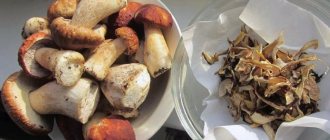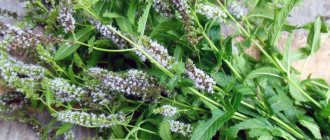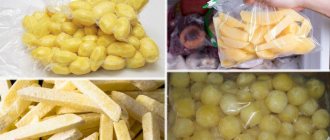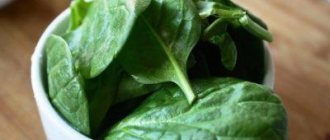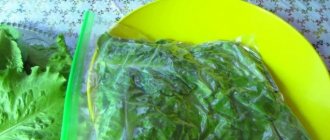Among the winter supplies, not the least place is occupied by dried apples. They contain quite a lot of useful substances.
When properly stored, dried apples do not spoil for a long time. But for this it is necessary to choose a container and ensure high-quality storage conditions.
Read the article about whether and how to properly store dried apples at home, how best to organize storage in glass jars, bags, boxes, etc.
About shelf life: fragrant apples 3 years after drying, is it realistic?
According to GOST 32896-2014 “Dried fruits. General technical conditions", the shelf life of dried fruits is 12 months. But in reality, dried apples can be stored much longer - 3.4, sometimes 5 years. It all depends on the variety of apples, harvesting method and storage conditions.
- It is recommended to store apples dried at home in the sun or in the oven for 12 months;
- Dried apples prepared using an electric dryer and packaged in hermetically sealed glass jars can be stored for 24-36 months.
The benefits and harms of dried apples for human health, calorie content
These dried fruits consist of a large number of macro- and microelements, various vitamins that the body needs for proper functioning:
- vitamins K, E and B regulate blood circulation;
- ascorbic and other acids contribute to proper brain function;
- Selenium, copper, magnesium, iodine, copper, zinc, manganese, iron and other elements saturate the body and increase immunity.
Dried apples contain vitamins, macro- and microelements that are beneficial for humans
Dried apples contain the following substances:
- Minerals – magnesium, iron, iodine (improves blood quality, cardiovascular system, metabolism and supports the functioning of the hormonal system).
- Phytoncides (stop the growth of pathogenic bacteria and fungi).
- Tanning (have anti-inflammatory and antibacterial qualities).
- Organic acids - chlorogenic, malic, tartaric, arabic acids (resist infections, regulate acid-base balance).
- Sugar – sucrose, fructose, glucose (restore strength, promote rapid saturation of the body).
- Polysaccharide pectin components (reduce cholesterol levels).
- Flavanoids (resist cell damage by blocking the action of free radicals).
The calorie content of dried fruits is 231 kcal per 100 grams of product.
Using dried apples, a person fills his body with a large number of useful elements, but there are also some contraindications .
If you have diabetes or obesity, eating dried apples can negatively affect human health. In case of such pathologies, it is better to refuse to take dried fruits.
Apple dried fruits promote good digestion due to the content of pectin, dietary fiber and fiber. The components of these fruits, proteins, acids, essential oils and phytoncides, improve metabolism and have a beneficial effect on the formation of microflora in the intestines.
Dried apples - beneficial properties and vitamins:
Rule No. 1 – Comply with storage conditions
The first thing the housewife should take into account is that only clean, well-dried apples are suitable for long-term storage. They cannot show signs of mold. It is important that the dried apple ring remains elastic and soft, but that no juice is released when squeezed. This drying will be stored well if you follow the storage conditions:
- dry, ventilated room;
- protection from direct sunlight;
- temperature +0+10 degrees;
- clean and dry storage containers;
- no contact with fresh vegetables, fruits, household chemicals.
Rule #2 – Store dried apples in suitable containers
For dried apples, it is not necessary to use airtight storage containers such as vacuum bags, glass jars, etc. In some cases, sealing can even be harmful. It is much more important to pay attention to cleaning the container. There should be no dirt, debris, or plaque on the walls. All this can cause the development of putrefactive processes and spoilage of the product.
In cardboard boxes
Cardboard boxes with a lid are suitable for storing dried apples. The main condition is that the lid must close tightly so that insects do not get inside through the cracks.
Cardboard containers absorb moisture and reduce the risk of dried apples becoming moldy.
It preserves better apples dried at home in the sun or in the oven. As a rule, such drying dries unevenly, and in a sealed space it quickly begins to deteriorate.
In fabric bags
Storing dried apples in bags is an old ancestral method that is still used in villages to this day. You can sew the bags yourself from thick cotton fabric or use an old pillowcase for storage. But the best linen fabric for storing dried fruits is considered to be a tightly woven linen fabric.
We recommend: How to preserve fresh herbs in the refrigerator for a long time: 8 simple ways
Fabric bags allow air to pass through well, so dried apples in them never become moldy.
But at the same time, small bugs and moths can penetrate inside. The bags must be tied. In villages, to keep them dry from insects, rag bags are soaked in a strong salt solution (1 kg of coarse salt per 5 liters of water). The bags are soaked for 8 hours and then dried well in the sun.
In glass jars
Glass containers are considered the most hygienic. Dried apples can be stored in a jar for as long as possible without loss of aroma and taste. In addition, insects cannot get into a tightly sealed glass jar. Foreign odors, moisture and oxygen do not penetrate into it. The smell of apples does not disappear even after 3-4 years.
It is true that only well-dried and clean dried fruits can be stored in a jar. Otherwise, the lack of air and natural ventilation will play a cruel joke, and the remaining moisture will lead to rapid molding of the workpiece.
Note. Typically, apples dried in a dehydrator (electric dryer) are stored in glass jars. In it, the fruits are dried more efficiently and evenly.
In plastic containers
Plastic trays are almost as good for storing dried apples as glass jars. They do not allow air, moisture, odors to pass through, and are also much stronger and lighter. You don’t have to worry that the drying container will fall and break. The downside is that the plastic itself can be a source of unpleasant odors.
To store dried apples, you should use containers made exclusively from food-grade plastic with appropriate markings.
It is best to purchase a new container. Over time, plastic products become covered with scratches, which retain bacteria. They can absorb food odors. Dried apples cannot be stored in such containers.
Fruit preparation
Which apples to choose
To obtain high-quality and tasty products for the winter, you should use thin-skinned, medium-sized fruits - they have small seed chambers, so there will be less waste during the cutting process.
Autumn varieties with a sweet and sour taste are best suited for storage (sweet apples have a weak taste and aroma after drying). The best varieties are recognized as Antonovka, Pepin and Aport.
Processing technology
First, the fruits are washed, unnecessary fragments are cut out - places of damage by worms and mechanical injuries.
The apples are cut in half, the core is cut out and the stalk is removed. Then cut into slices 0.3-0.5 cm thick.
Next, you need to dry the slices; for this, housewives use different methods:
- in the sun on warm summer days;
- in the oven at a temperature of 50-50°, stirring regularly;
- in an electric dryer - at a certain temperature specified in the instructions, after 2-3 hours the drying reaches full readiness;
- in the microwave at 300 watts for 2-3 minutes.
With this method of harvesting, drying preserves all vitamins and nutrients.
Rule #4 – Use paper
The bottom of the jar, plastic container or fabric bag in which you plan to store dried apples must be covered with parchment.
Parchment paper protects products from unpleasant odors, reduces the negative effects of temperature changes, high humidity, etc.
If you don't have parchment, you can use other clean, thick paper, such as office paper. It is important to avoid contact of products with newspapers and other printed materials containing printing ink.
Destruction of parasites
You can get rid of insects from apples
If you notice insects in dried apples, do not rush to throw them away, because... they can still be saved. There are several ways:
- Transfer the product to a baking sheet and place in the oven for half an hour at a temperature of 60°. The same method is effective in case of mold. But it is not recommended to use a moldy product for food, even after careful processing.
- The second option is to place the dryer in the freezer for an hour. During frost, all parasites, incl. The larvae of aphids and moths die safely.
- The containers in which insects have infested must be treated - glass jars should be washed and baked in the oven, the cardboard box should be replaced with a new one, the fabric bag should be washed with soap and ironed.
Rule No. 5 – Choose a suitable place in the apartment or house
It is best to store dried apples in an apartment or house in a cool pantry.
It is dark and quite dry here, there are no heating devices, which are contraindicated for dried fruits. If the dryer is in a bag or cardboard box, it is important not to place it on the floor. You need to allocate space for it on the shelf, or use a stand.
We recommend: Under what conditions in winter is it acceptable to store vegetables on the balcony?
Other places that are suitable for storing dried apples at home:
- basement or cellar (for drying apples in plastic trays and jars);
- kitchen table drawer, remote from heating appliances and piping;
- insulated balcony or loggia.
Advice. If dried apples are placed on the balcony in a transparent container, you should come up with a sun curtain for them. If exposed to direct sunlight, the dryer may darken and disappear quickly.
Methods of application
Many housewives try to dry apples for the winter. There are a lot of options for using the finished product - some prepare drinks and fruit drinks, others bake pies with a savory apple filling, others even add it to porridge or eat it as a dessert. But the most favorite option is compote with a taste familiar to everyone from early childhood.
To get a drink with a rich taste, amber color and fragrant aroma you will need:
- 3 liters of filtered water;
- 300 g dried apples;
- 7 tablespoons sugar;
- lemon juice - to taste and desire.
Cooking method:
- The raw materials need to be sorted out and washed thoroughly under the tap.
- Soak in cold water for 30 minutes.
- Place in a colander again and let the water drain completely.
- Pour the required amount of water into the pan, place the swollen slices and place on medium heat.
- After boiling, add sugar, reduce the flame and cook for 20 minutes.
- Before the end of cooking, you can add a cinnamon stick, cardamom seeds, vanilla sugar or lemon or orange peel to the drink.
- Leave the finished compote for an hour to steep. After which it will be ready for use.
Dried apple fruits are healthy, tasty and indispensable in winter, as they save you from vitamin deficiency and support your immune system. It is quite possible to store the product both in a private house and in an apartment; the main thing is to create optimal conditions and choose the right place and container for storage.
Rule No. 6 – Avoid harmful neighborhoods
Dried apples absorb odors very quickly.
It is enough to stand them next to spices, onions or other products for one day so that the pleasant aroma of apples is distorted beyond recognition. All bright-smelling products are considered harmful for apple drying. Among them:
- citrus fruit;
- bananas;
- cabbage;
- potato;
- garlic and onion;
- herbs.
You should also remember that the main source of moths and bugs are cereals, flour and pasta. If the housewife is not sure of their purity, the products should be kept in quarantine for some time, separately from dried apples.
Note. This rule applies to drying materials stored in boxes and fabric bags.
For dried apples in boxes and bags, storage in cellars, garages and basements is generally not recommended. It is better to place supplies in the pantry among preserved food in jars or on a glassed-in loggia.
Which varieties are best for drying?
For drying, it is advisable to select fruits that have a small seed pod and thin skin . Prepared sorted fruits are washed and cut into pieces or circles.
The best apple varieties for storage are those that have dense white flesh and are sour or sweet and sour.
These include:
- Titovka;
- Aport;
- Pippin;
- Antonovka;
- Grushovka and others.
It is recommended to send apples for drying immediately after cutting. This way all the beneficial qualities of the fruit will be preserved in the best possible way.
Damaged and rotten areas should be cut off . If drying is carried out in the open air, the laid out pieces of apples are covered with gauze on top, protecting them from flies and beetles.
You can dry almost any apples after removing the damaged areas. But from sweet varieties the yield of dry product will be much less, and the taste after drying will be less pronounced.

